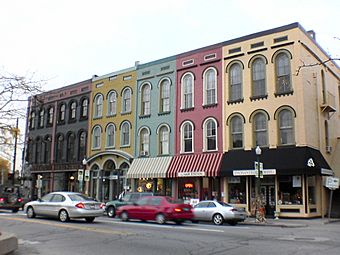Ypsilanti Historic District facts for kids
The Ypsilanti Historic District is a special area in the heart of Ypsilanti, Michigan. It stretches along both sides of the Huron River. This district is important because it protects many old buildings and places. It was first recognized as a Michigan State Historic Site in 1973. Later, in 1978, it was added to the National Register of Historic Places. This is a list of places across the country that are important to history. More parts of the district were added to this list in 1989.
|
Ypsilanti Historic District
|
|

Buildings on East Cross Street
|
|
| Location | Along Huron River with boundaries extending to Forest Ave., Prospect & Grove Sts., Buffalo St., and Hamilton & Summit Sts., Ypsilanti, Michigan |
|---|---|
| Area | 240 acres (97 ha) and 125 acres (51 ha) (addition) |
| Architect | Samuel C. Falkinburg; Jordan & Anderson |
| Architectural style | Greek Revival, Queen Anne, Italian Villa, Late 19th And 20th Century Revivals, Bungalow/craftsman, Late Victorian |
| NRHP reference No. | 78001515, 88003055 |
Quick facts for kids Significant dates |
|
| Added to NRHP | April 11, 1978 and January 5, 1989 (addition) |
Contents
What is the Ypsilanti Historic District?
The Ypsilanti Historic District includes many of the city's oldest business areas. It also covers the neighborhoods around them. The main part of the district is quite large. It stretches from Grove Street in the east to Hamilton Street in the west. It goes from Forest Avenue in the north to Buffalo Street in the south.
How Big is the Historic District?
In 1989, more areas were added to the district. One addition is in the northeast, along Forest, Oak, and Maple Streets. It goes east to Prospect Street. Another part was added in the south, along South Adams Street. A western addition expanded the district to Summit Street. This historic district is the third largest in the entire state of Michigan!
A Look Back: History of Ypsilanti
The city of Ypsilanti was started in 1823. It became a very important stop for trains when a railroad line was built through the city in 1838. As Ypsilanti grew, a shopping area appeared on the Detroit-Chicago Road. Today, this road is known as Michigan Avenue.
How Ypsilanti's Downtown Grew
In the late 1840s, another shopping area began to grow. This was a few blocks northeast, close to the train station. This area is now called Depot Town. In 1851, a big fire destroyed a large part of the Michigan Avenue business district. But the buildings were quickly rebuilt. Many of these buildings from the 1850s are still standing today. You can see them in the heart of the historic district.
Exploring the Buildings in the District
The main part of the Ypsilanti Historic District has about 400 important buildings. These are found in two main areas. One area is the business center along Michigan Avenue. The other is near the railroad depot on Cross Street, which is Depot Town. Huron Street runs next to the river and connects these two areas. The buildings along Huron Street are mostly homes.
What Kinds of Homes Can You See?
The homes in the district show different styles of architecture. You can see many examples of Greek Revival homes. There are also beautiful Queen Anne houses. Many brick Italianate houses are also part of the district. These homes are often unique and show how people lived long ago.
What About the Shops and Businesses?
The business buildings are mostly original structures. They are usually two or three stories tall and made of brick. The newer parts of the district also have interesting buildings. The northeast addition has homes built in the late 1800s and early 1900s. These include Greek Revival, Queen Anne, and Tudor Revival styles. Some are modest family homes, while others were grand houses for important people.
The southern addition has 12 more homes, mostly simple frame houses. The western addition adds over 300 more buildings. Most of these are single-family homes. Many have been changed into apartments or fraternity houses. This is because they are close to Eastern Michigan University.



